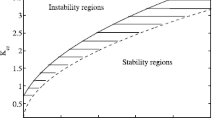Abstract
The interaction of charged dust grains with nonlinear vortical structures in the Earth’s atmosphere is analyzed. Certain aspects of the atmosphere−ionosphere interaction, in particular, mechanisms for the appearance of dust grains at ionospheric altitudes, are discussed. It is shown that, at certain altitudes, there are regions in the wavenumber space in which conditions leading to the excitation of acoustic−gravity waves are satisfied. The interaction of nonlinear acoustic−gravity waves with dust grains of meteoric origin at ionospheric altitudes, which leads to the mixing and redistribution of dust grains over the region where vortices exist, is investigated. The possibility of formation of vertical and horizontal dust flows in dusty ionospheric plasma as a result of modulational instability is analyzed. The dynamics of dust grains in dust devils frequently arising in the atmosphere above well-heated surfaces is modeled. The vortical structure of such a dust devil is characterized by a reduced pressure in the center, which facilitates the lifting of small dust grains from the surface. The formulated model is used to calculate the trajectories of dust grains in dust devils with allowance for the influence of the electric field generated in the vortex by colliding dust grains. The calculations show that dust devils play an important role in the transport of dust grains.
Similar content being viewed by others
References
S. I. Kopnin, S. I. Popel, and T. I. Morozova, Plasma Phys. Rep. 41, 171 (2015).
Yu. N. Besedina and S. I. Popel, Dokl. Earth Sci. 423A, 1475 (2008).
Yu. N. Izvekova, S. I. Popel, and B. B. Chen, J. Atmos. Sol.-Terr. Phys. 134, 41 (2015).
Z. Ceplecha, J. Borovička, W. G. Elford, D. O. ReVelle, R. L. Hawkes, V. Porubčan, and M. Šimek, Space Sci. Rev. 84, 327 (1998).
D. M. Hunten, R. P. Turco, and O. B. Toon, J. Atmos. Sci. 37, 1342 (1980).
K. Amyx, Z. Sternovsky, S. Knappmiller, S. Robertson, M. Horanyi, and J. Gumbel, J. Atmos. Sol.-Terr. Phys. 70, 61 (2008).
A. Hasegawa and P. K. Shukla, Phys. Lett. A 332, 82 (2004).
D. J. Lacks and A. Levandovsky, J. Electrostat. 65, 107 (2007).
Y. Zhai, S. A. Cummer, and W. M. Farrell, J. Geophys. Res.: Planets 111, E06016 (2006).
W. Horton, H. Miura, O. Onishchenko, L. Couedel, C. Arnas, A. Escarguel, S. Benkadda, and V. Fedun, J. Geophys. Res. Atmos. 121, 7197 (2016).
Yu. N. Izvekova and S. I. Popel, Plasma Phys. Rep. 43, 1172 (2017).
Author information
Authors and Affiliations
Corresponding author
Additional information
Original Russian Text © Yu.N. Izvekova, S.I. Popel, 2018, published in Fizika Plazmy, 2018, Vol. 44, No. 9, pp. 747–751.
Rights and permissions
About this article
Cite this article
Izvekova, Y.N., Popel, S.I. Nonlinear Wave Structures and Plasma−Dust Effects in the Earth’s Atmosphere. Plasma Phys. Rep. 44, 835–839 (2018). https://doi.org/10.1134/S1063780X18090052
Received:
Published:
Issue Date:
DOI: https://doi.org/10.1134/S1063780X18090052




